Sunflowers (series of paintings)
| Original title, in French: Tournesols | |
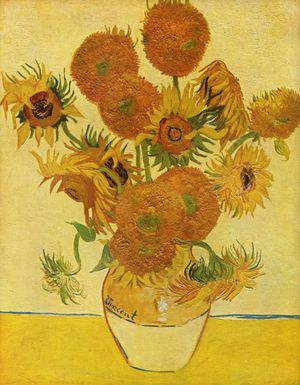 |
|
| Artist | Vincent van Gogh |
|---|---|
| Year | 1888 |
| Type | Oil on canvas |
| Dimensions | 92.1 cm × 73 cm (36.2 in × 28.7 in) |
| Location | National Gallery, London |
Sunflowers (original title, in French: Tournesols) are the subject of two series of still life paintings by the Dutch painter Vincent van Gogh. The earlier series executed in Paris in 1887 gives the flowers lying on the ground, while the second set executed a year later in Arles shows bouquets of sunflowers in a vase. In the artist's mind both sets were linked by the name of his friend Paul Gauguin, who acquired two of the Paris versions. About eight months later Van Gogh hoped to welcome and to impress Gauguin again with Sunflowers, now part of the painted décoration he prepared for the guestroom of his Yellow House where Gauguin was supposed to stay in Arles. After Gauguin's departure, Van Gogh imagined the two major versions as wings of the Berceuse Triptych, and finally he included them in his exhibit at Les XX in Bruxelles.
As Van Gogh anticipated in 1889, the Sunflowers finally became his, and served - combined with self-portraits - as his artistical arms and alter ego up to the present day: no retrospective Van Gogh exhibition since 1901 voluntarily missed to include them, and a wealth of forgeries as well as record-setting price paid at auction acknowledges their public success: Perhaps, because Van Gogh's Sunflowers are more than his or him - they may be considered, as Gauguin put it, the flower.
Contents |
The Paris Sunflowers
Little is known of Van Gogh's activities during the two years he lived with his brother Theo in Paris, 1886/1888. The fact that he had painted Sunflowers already in this time is only revealed in spring 1889, when Gauguin claimed one of the Arles versions in exchange for studies he had left behind after leaving Arles for Paris. Van Gogh was upset and replied that Gauguin had absolutely no right for this request: "I am definitely keeping my sunflowers in question. He has two of them already, let that hold him. And if he is not satisfied with the exchange he has made with me, he can take back his little Martinique canvas,[1] and his self-portrait sent me from Brittany,[2] at the same time giving me back both my portrait[3] and the two sunflower canvases which he has taken to Paris. So if he ever broaches this subject again, I've told you just how matters stand."[4]
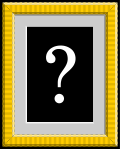


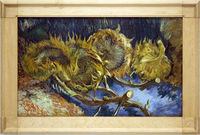
The two Sunflowers in question show two buttons each, one of them was preceded by a small study, and a fourth large canvas combines both compositions. The two other pictures that are not shown, (with a question mark) are not available, for educational purposes.
These were Van Gogh's first paintings with "nothing but sunflowers" - yet, he had already included sunflowers in still life and landscape earlier.

Oil on canvas, 50 × 61 cm
Kunsthalle Mannheim
The Arles Sunflowers
Now that I hope to live with Gauguin in a studio of our own, I want to make decorations for the studio. Nothing but big flowers.[5]
See Letter 527
Leaving aside the first two versions, all Arlesian Sunflowers are painted on size 30 canvases.
The initial versions, August 1888
None meets the descriptions supplied by Van Gogh himself in his announcement of the series in every detail: The first version differs in size, is painted on a size 20 canvas—not on a size 15 canvas as indicated[6]—and all the others differ in the number of flowers depicted from Van Gogh's announcement.
- The second was evidently enlarged and the initial composition altered by insertion of the two flowers lying in the foreground, center and right.[7]
- Neither the third nor the fourth shows the dozen or 14 flowers indicated by the artist, but more—fifteen or sixteen.[8]
These alterations are executed wet-in-wet and therefore considered genuine rework—even the more as they are copied to the repetitions of January 1889: There is no longer a trace of later alterations, at least in this aspect.
 Sunflowers, first version: turquoise background |
 Sunflowers, second version: royal-blue background |
 Sunflowers, fourth version: yellow background |
The Repetitions, January 1889
 Sunflowers, repetition of the 3rd version |
 Sunflowers, repetition of the 4th version (yellow background) |
 Sunflowers, replica of the 4th version (yellow green background) |
Both repetitions of the 4th version are no longer in the original state. In the Amsterdam version a strip of wood was added at the top - probably by Van Gogh himself. The Tokyo version, however, was enlarged on all sides with strips of canvas, which were added at a later time - presumably by the first owner, Emile Schuffenecker.[10]
The Berceuse-Triptych
In January 1889, when Van Gogh had just finished the first repetitions of the Berceuse and the Sunflowers pendants, he told his brother Theo: I picture to myself these same canvases between those of the sunflowers, which would thus form torches or candelabra beside them, the same size, and so the whole would be composed of seven or nine canvases.[11] A definite hint for the arrangement of the triptych is supplied by Van Gogh's sketch in a letter of July 1889.[12]

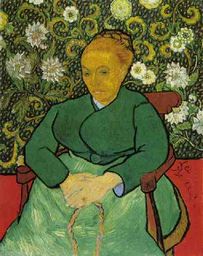
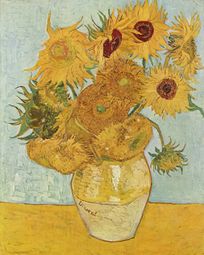
Later this year, Van Gogh selected both versions for his display at Les XX, 1890.
Sunflowers, friendship and gratitude
Van Gogh began painting in late summer 1888 and continued into the following year. One went to decorate his friend Paul Gauguin's bedroom. The paintings show sunflowers in all stages of life, from fully in bloom to withering. The paintings were innovative for their use of the yellow spectrum, partly because newly invented pigments made new colours possible.
In a letter to his brother Theo,[13] Van Gogh wrote:
"It is a kind of painting that rather changes in character, and takes on a richness the longer you look at it. Besides, you know, Gauguin likes them extraordinarily. He said to me among other things - 'That...it's...the flower.' You know that the peony is Jeannin's, the hollyhock belongs to Quost, but the sunflower is somewhat my own."
Sunflowers and the Van Gogh myth
On March 31, 1987, even those without interest in art were made aware of van Gogh's Sunflowers series when Japanese insurance magnate Yasuo Goto paid the equivalent of US $39,921,750 for Van Gogh's Still Life: Vase with Fifteen Sunflowers at auction at Christie's London, at the time a record-setting amount for a work of art.[14] The price was over four times the previous record of about $12 million paid for Andrea Mantegna's Adoration of the Magi in 1985. The record was broken a few months later with the purchase of another Van Gogh, Irises, by Alan Bond for $53.9 million at Sotheby's, New York on November 11, 1987.
While it is uncertain whether Yasuo Goto bought the painting himself or on behalf of his company, the Yasuda Fire and Marine Insurance Company of Japan, the painting currently resides at Seiji Togo Yasuda Memorial Museum of Modern Art in Tokyo. After the purchase, a controversy arose whether this is a genuine van Gogh or an Emile Schuffenecker forgery.
Provenances
- Two Paris versions Van Gogh himself exchanged with Gauguin in December 1887 or January 1888, who sold both to Ambroise Vollard: one in January 1895 and the other in April 1896:
- the first was for a short time with Félix Roux, but reacquired by Vollard and sold to Degas; from his estate to Rosenberg, then to Hahnloser and bequested to the Kunstmuseum Bern.
- the second was acquired by the Dutch collector Hoogendijk, at the sale of his collection by Kann who ceased the painting to Richard Bühler; then via Thannhauser to the Met, New York
- Two of Van Gogh's Sunflowers paintings never left the artist's estate:
- the study for one of the Paris versions (F.377) and
- the repetition of fourth version (F.458).
Both are in the possession of the Vincent van Gogh Foundation, established 1962 by Vincent Willem van Gogh, the artist's nephew, and on permanent loan to the Van Gogh Museum, Amsterdam.
- Five other versions are recorded in the Van Gogh estate papers[15]
- the final Paris version (F.452) in the artist's estate was sold 1909 via C. M. van Gogh, The Hague (J. H. de Bois) to Kröller-Müller
- (F.457) sold 1894 to Emile Schuffenecker
- (F.456) sold 1905 via Paul Cassirer to Hugo von Tschudi
- (F.459) sold 1908 C. M. van Gogh (J. H. de Bois), The Hague to Fritz Meyer-Fierz, Zürich
- (F.454) sold 1924 via Ernest Brown & Phillips (The Leicester Gallery) to the Tate Gallery; since on permanent loan to the National Gallery, London
- Two Arles versions left the artist's estate unrecorded
- (F.453)
- (F.455)
Resources
Notes
- ↑ Wildenstein
- ↑ Wildenstein
- ↑ Selfportrait à l'ami Gauguin
- ↑ Letter 571
- ↑ Letter 526
- ↑ Dorn 1990, pp. 336-337
- ↑ Dorn 1990, pp. 344-348
- ↑ Dorn 1990, pp. 337-340; 340-343 and Van Tilborgh & Hendricks, pp.
- ↑ http://www.sompo-japan.co.jp/museum/english/
- ↑ See Dorn 1999, pp.
- ↑ Letter 574
- ↑ Letter 592
- ↑ Letter 573
- ↑ Clines, Francis X. (1987-03-31). "Van Gogh Sets Auction Record: $39.9 Million". The New York Times. http://query.nytimes.com/gst/fullpage.html?res=9B0DE3DB1F3DF932A05750C0A961948260. Retrieved 2008-06-13.
- ↑ Dorn 1999 and Stolwijk & Veenenbos 2002
References
- Tellegen, Annet: Vincent en Gauguin: schilderijenruil in Paris, Museumjournaal 11, 1966, pp. 42-45
- Hoffmann, Konrad: Zu van Goghs Sonnenblumenbildern, Zeitschrift für Kunstgeschichte 31, 1968, pp. 27-58
- Dorn, Roland: "Décoration": Vincent van Goghs Werkreihe für das Gelbe Haus in Arles, Georg Olms Verlag, Hildesheim, Zürich & New York, 1990, pp. 58-61, 73-80, 113-117, 335-348, 455-462 ISBN 3-487-09098-8
- Welsh-Ovcharov, Bogomila: The Ownership of Vincent van Gogh's 'Sunflowers', Burlington Magazine, March 1998, pp. 184-192
- Dorn, Roland: Van Gogh's 'Sunflowers' series: the fifth toile de 30, Van Gogh Museum Journal 1999, pp. 42-61
- Van Tilborgh, Louis & Hendriks, Ella: The Tokyo 'Sunflowers': a genuine repetition by Van Gogh or a Schuffenecker forgery?, Van Gogh Museum Journal 2001, pp. 17-43
- Stolwijk, Chris, & Veenenbos, Han: The account book of Theo van Gogh and Jo van Gogh-Bonger, Van Gogh Museum, Amsterdam & Primavera Press, Leiden 2002 ISBN 90-74310-82-6
External links
- [email protected], the complete series of paintings.
- [email protected], offers an analysis of two sunflower paintings.
|
|||||||||||||||||||||||||||||||
